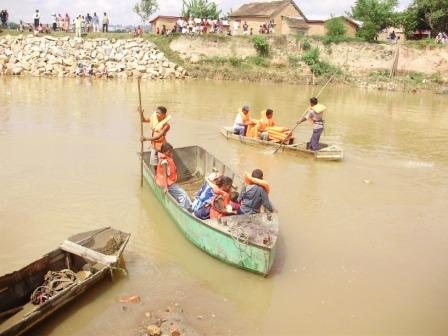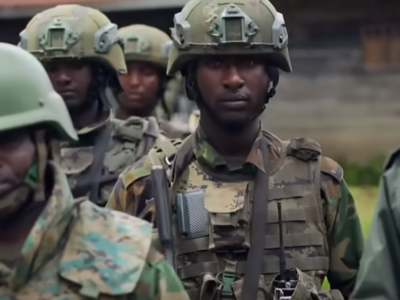In the past days, Madagascar has been sandwiched between both Tropical Storm Eric and Cyclone Fanele. Considering that last year's cyclone season was particularly deadly, bloggers in Madagascar are weary of the consequences of such natural disasters. Despite growing political tension, many of them reacted promptly to share their thoughts on what seems to be another series of damaging catastrophes.
Tropical Storm Eric made landfall on Monday, January 19, in the region of Fenerive-Est (East coast of Madagascar) with wind speeds reported around 100 km/h. Early morning on Wednesday, Cyclone Fanele hit Morondava and its surroundings with wind gusts up to 240 km/h.
Blogger Tomavana describes the general sentiment in Madagascar:
Tropical Storm Eric traveled along the coast of Analanjirofo and Atsinanana regions on the East coast of Madagascar. We can say that once again, the violent winds are piling on against Madagascar.
Lomelle explains that the district of Fenerive Est was already severely damaged by cyclone Ivan last year (Fr). She adds that authorities seem more prepared this time around in the capital city:
Madagascar ne peut éviter les passages de ces tempêtes tous les ans mais l’essentielle est de se tenir prêts aux éventualités [..] L’exercice de simulation d’Anosimahavelona était spécifique par rapport aux autres quartiers parce que le fleuve d’Ikopa est l’enjeu. Le travail consistait l’évacuation au moment du danger, à la traversée des sinistrés pour sortir de l’inondation à l’aide de pirogues, puis au transport par des camions pour rejoindre les sites d’hébergement. [..] Après cet exercice, il se peut que le taux des sinistrés puisse baisser car la prévention est bien préparée et assurée.

Flooding evacuation excercise by Lomelle
Tomavana adds in a follow up post that the initial temporary reports from the passage of Cyclone Fanele in the Southwest region are extremely worrisome (Fr):
- A cause de l’extrême violence des rafales [> 260 kmh] plus aucune maison d’habitation n’a de toit dans le district de Morondava.
– Le journal Express de Madagascar avance le bilan des sans abris à “environ 64 000 personnes sur les 80 000 habitant la ville n’ont plus de toit.”
– Aucune nouvelle du district de Manja depuis hier 23h00 locale.
– L’onde de tempête a provoqué des raz-de-marée dans la région de Belo-sur-Mer et Ankoba.
The newspaper Express de Madagascar estimates that 64,000 out of the 80,000 total population are now roofless.
The county of Manja has been cut out of all communication since 23h00 local time yesterday (Jan 20th).
The storm also induced tidal waves in the Belo-sur-Mer region and Ankoba.







22 comments
Any word on how much rainfall the cyclones have dropped on the hard hit areas? What about loss of human and animal life?
Hello Lynn,
Official but temporary reports from national authorities have just come in:
– 1) 9, 471 people without homes, 1 wounded and no reported casualties as of now.
-2) 80% of infrastructure of the city of Morondava (buildings, power cables etc) are destroyed.
-3) local authorities estimates ~1,000 ha of rice fields are under water.
Source translated from French:
– http://www.lexpressmada.com/index.php?p=display&id=24022
– http://www.les-nouvelles.com/default.php?file=article&mode=detail2&id=43075
Are there any media sources in the Madagascar area that can confirm info about some sailers from the USA missing at sea from the storm ? Renowned sailor-Quin Cultra from Onarga, Illinois, USA and Leo Sherman of Gilman, Illinois, USA and a third person were reported missing, their boat capsized in the Indian Ocean off the coast of Madagascar.
Carl,
How did you hear about the missing sailors?
Lynn
>sailers from the USA missing at sea from the storm
Hi Carl & Lynn,
I found two articles in French. Hope it could help :
“Un bateau a sombré à 300 kilomètres au large de Tolagnaro [Fort-Dauphin]. Trois ressortissants américains étaient à bord. L’un a survécu mais ses deux compatriotes se sont noyés. Leurs corps demeurent introuvables. Le naufrage s’est produit mercredi.” l’Express de Madagascar – 23.01.2009
“Le Queequeg-II aurait quitté l’île Maurice le 16 janvier dernier pour rejoindre le port de Taolagnaro [Fort-Dauphin]. Tout se déroulait pour le mieux pour les trois membres de l’équipage, du moins jusqu’au 20 janvier où ils ont été surpris par le cyclone Eric alors qu’ils n’étaient plus qu’à 30km de leur destination finale.” les Nouvelles – 23.01.2009
The Nivôse rescue mission, after the Sinking of Queequeg II (Nivôse is a French frigate based in Reunion, hull number F.732) :
“Au cours de leur première plongée, comme le survivant Leo Sherman l’avait laissé escompter, les marins espèrent retrouver son compagnon le Dr Joe Strykowski dans l’un des flotteurs du Queequeg II retourné. Ils découvrent dans un premier temps le boot qui avait servi de “fil d’Ariane” entre les deux hommes, avant que Sherman ne perde de vue Strykowski lorsque lui-même parvenait à gagner le flotteur équipé d’une trappe pour sortir au-dessus du niveau de la mer, après un jour et demi passé réfugiés dans la cabine. Le niveau d’eau montant dangereusement dans l’habitacle, les deux hommes avaient alors tenté de s’échapper à la nage. Le cas du skipper Quen Cultra, ejecté lors du passage de la tempête, ne laissant malheureusement pas le moindre doute quant à sa disparition. “Pendant un moment, on a gardé l’espoir de retrouver un deuxième rescapé. Lorsque j’ai cogné avec mon poignard contre la coque, j’avais l’impression qu’on me répondait par des coups à l’intérieur”, raconte le Maître Cloarec, l’un des plongeurs du Nivôse. Malheureusement, lorsqu’ils parviennent enfin à pénétrer à l’intérieur de la coque, ils ne trouvent que débris et objets tanguants, ceux-là même qui cognaient contre la coque en réponse aux appels du plongeur.” clicanoo.com – 25.01.2009 >>
Thank you Tomavana for this update on the boat that capsized off the coast of Madagascar.
I will forward the news to Carl. It’s very sad that unlike Leo Sherman, his companions did not survive this disaster.